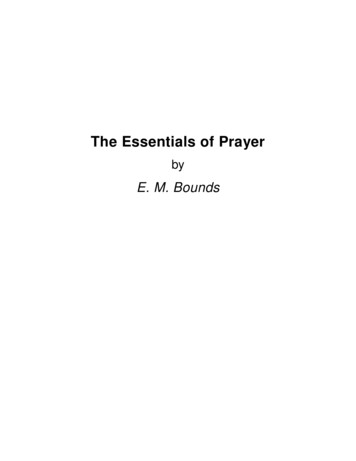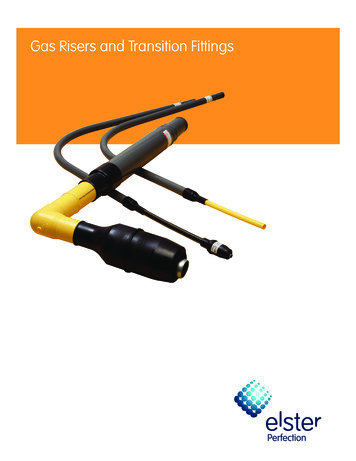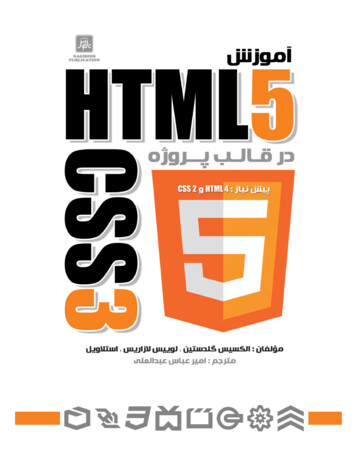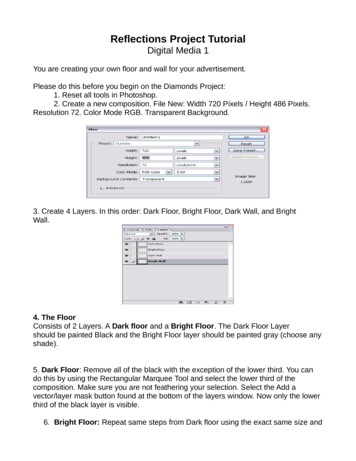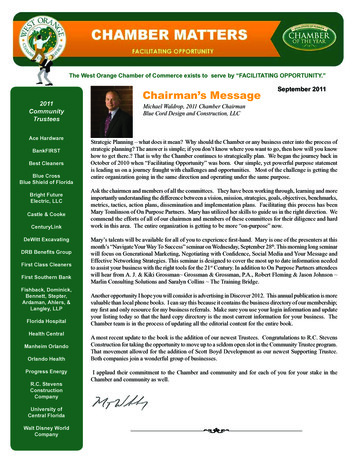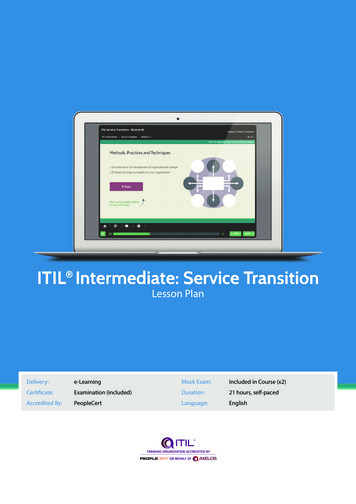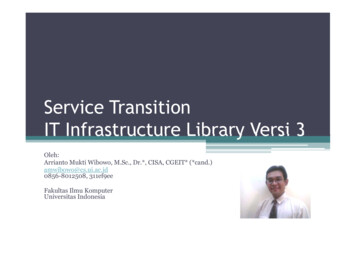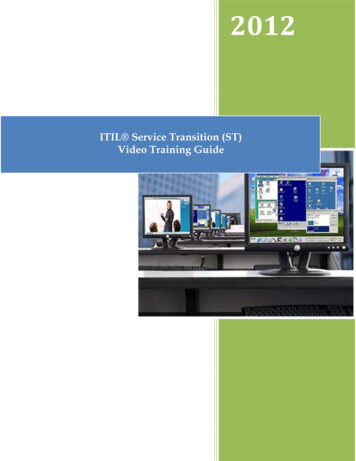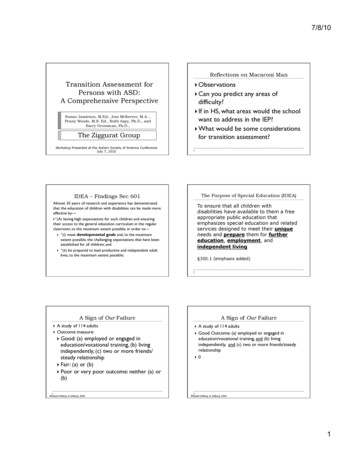
Transcription
7/8/10Reflections on Macaroni ManTransition Assessment forPersons with ASD:A Comprehensive PerspectiveSusan Jamieson, M.Ed., Ann McKeever, M.A. ,Penny Woods, M.S. Ed., Ruth Aspy, Ph.D., andBarry Grossman, Ph.D.,The Ziggurat Group Observations Canyou predict any areas ofdifficulty? If in HS, what areas would the schoolwant to address in the IEP? What would be some considerationsfor transition assessment?Workshop Presented at the Autism Society of America ConferenceJuly 7, 2010The Purpose of Special Education (IDEA)IDEA – Findings Sec 601Almost 30 years of research and experience has demonstratedthat the education of children with disabilities can be made moreeffective by— ‘‘(A) having high expectations for such children and ensuringtheir access to the general education curriculum in the regularclassroom, to the maximum extent possible, in order to— ‘‘(i) meet developmental goals and, to the maximumextent possible, the challenging expectations that have beenestablished for all children; and ‘‘(ii) be prepared to lead productive and independent adultlives, to the maximum extent possible;To ensure that all children withdisabilities have available to them a freeappropriate public education thatemphasizes special education and relatedservices designed to meet their uniqueneeds and prepare them for furthereducation, employment, andindependent living§300.1 (emphasis added)A Sign of Our Failure A study of 114 adultsOutcome measure:Good: (a) employed or engaged ineducation/vocational training, (b) livingindependently, (c) two or more friends/steady relationship Fair: (a) or (b) Poor or very poor outcome: neither (a) or(b)A Sign of Our Failure Billstedt Gillberg, & Gillberg, 2005" A study of 114 adultsGood Outcome: (a) employed or engaged ineducation/vocational training, and (b) livingindependently, and (c) two or more friends/steadyrelationship0Billstedt Gillberg, & Gillberg, 2005"1
7/8/10A Sign of Our Failure A study of 114 adultsFair: Either (a) employed or engaged in education/vocational training, or (b) living independently. (c)two or more friends/steady relationship (notrequired)8%A Sign of Our Failure Billstedt Gillberg, & Gillberg, 2005"A study of 114 adultsPoor or very poor outcome:Neither (a) employed or engaged ineducation/vocational training, nor (b) livingindependently, (c) two or more friends/steady relationship92%With no differences between individuals with autismwho are considered high functioning and those with amore classic presentationBillstedt Gillberg, & Gillberg, 2005"OutcomeFindings of a 2002 U.S. study of 405children and adults on the spectrum(Seltzer and Krauss, 2002) Of adults 22 and older, 73% lived withtheir parents 90% could not gain or keep employment 95% had difficulty making and keepingfriendsA Study in Contradictions 22%have IQs in the superior to verysuperior range 12% are employed full-time** 1% of this 12% are employed in an area inwhich they were trained/educated**most did not have interventions at a young ageTransition IEP Requirements Beginning not later than the first IEP to be ineffect when the child turns 16, or younger ifdetermined appropriate by the IEP Team, andupdated annually, thereafter, the IEP mustinclude(1) Appropriate measurable postsecondary goalsbased upon age appropriate transitionassessments related to training, education,employment, and where appropriate,independent living skills; and (2) The transition services (including courses ofstudy) needed to assist the child in reachingthose goals. The Purpose of Special Education (IDEA) prepare them forfurther educationEmploymentindependent livingIDEA 300.320(b)2
7/8/10What is Transition Assessment?According to the Division on CareerDevelopment and Transition (DCDT) of CEC Transition assessment is an “ ongoing process ofcollecting data on the individual’s needs, preferences,and interests as they relate to the demands ofcurrent and future working, educational, living, andpersonal and social environments. Assessment dataserve as the common thread in the transition processand form the basis for defining goals and services tobe included in the [IEP.]”While we assume 16 years, it can start sooner!FYI: Transition AssessmentAssessment of any skills related to personalautonomy and self-determination can broadlybe considered as related to transitionassessment although, not specific to secondaryor post-secondary levels. Examples: Ability to communicate effectively Independent work habits and skills Associating with peers The biggest predictor of employment for adultsis a job experience during high school.Why are we NOT focusing onacademics?They are important, but Research Shows That Individualswith “soft skills”, includinggood social skills, sociability, good workhabits, punctuality, conscientiousness andthose who participated in extra curricularactivities are more likely to make moremoney, be employed, and attain higherlevels of education than those with goodgrades and high standardized test scores.Llears (2008). Do social skills matter? The contribution of noncognitive factors inexplaining differences in educational attainment and earnings. Social Science Research,37, 888-902. Transition ServicesDefinition under IDEA‘transition services’ means a coordinated setof activities for a child with a disability.(A) is designed to be a results-orientedprocess, that is focused on improving theacademic and functional achievement ofthe child with a disability to facilitate thechild's movement from school to postschool activities IDEA(2004)emphasisadded3
7/8/10Transition ServicesDefinition (continued) Law(B) is based on the individual child’s needs,taking into account the child's strengths, preferences,and interests(C) includes instruction, related services, communityexperiences, the development of employmentand other post-school adult living objectives,and, when appropriate, acquisition of daily living skillsand functional vocational evaluation.Transition in Texas Beginningat any age. . . Futures planningfor integrated living, work, community,and educational environments thatconsiders skills necessary to function incurrent and post-secondaryenvironments IDEA(2004)emphasisaddedExamples of Transition AssessmentTools – Traditional Assessment InterestSurveys and InventoriesMeasures More in-depth skills assessments oragency assessments, such as VocationalRehab evaluations Functional Performance/Life Skills lEduca@onChapter89SubchapterAAExamples of Transition AssessmentTools – recent considerations AdaptiveBehavior measures (consideringpotential differences across settings*) Self-Determination Scales (measures ofempowerment, self-advocacy skills) Other assessments (e.g., executivefunction, situational assessment, etc.)Lee, H.J., & Park, H. (2007). An integrated literature review on the adaptive behavior of individualswith Asperrger Syndrome. Remedial and Special Education, 28, 132-139.Adaptive Behavior MeasuresSelf-Determination Measures AIRSelf-Determination Scale andUser Guide The Arc’s Self-DeterminationScale Choicemaker Self-DeterminationAssessment Vineland AdaptiveBehavior Scales, SecondEdition (Vineland-II) Adaptive Behavior Assessment System,Second Edition (ABAS-II) Scales of Independent Behavior, Revised(SIB-R)4
7/8/10Interests, Abilities and Values Surveys COPES, COPS, COPS-II, CAPS, COPS-PICMcCarron-Dial SystemReading Free Vocational Interest Inventory, SecondEditionPre-Vocational Assessment Screen (PAS)Skills Assessment Module (SAM)Vocational Training & Interest Survey (Voc-Ties)Armed Services Vocational Aptitude Battery (ASVAB)Wide Range Interest and Occupation Test, SecondEdition (WRIOT-II)Functional Performance and Life Skills Functional(FSSI) Ansell-CaseyLife Skills Assessment Brigance Life Skills/Employability SkillsInventory TEACCH Transition Assessment Profile,Second Edition (TTAP-2)Traditional Assessments Have provided us with some useful informationHas our use of these instruments been sufficientto achieve the outcomes we need for personswith ASD?Is there a way we can enhance our transitionassessment process to improve outcomes?Are we adequately considering the impact of ASDwhen interpreting transition results anddetermining interventions?Underlying Characteristics ChecklistSkills Screening InventoryAdditional Tools to ConsiderUnderlyingCharacteristicsChecklist (UCC) –Classic (CL) or HighFunctioning (HF) Individual Strengthsand Skills Inventory Intervention Ziggurat Assesses needs of theindividual in social,behavior, sensory,communication, motor,cognitive, emotional &medical areasAssesses the individual’sstrengths in the UCCareasFramework to designinterventionIndividual Strengths and Skills Inventory Helps you to “see” theautism Provides a “snapshot” ofhow autism is expressedfor an individual A descriptive instrument Can be completed by ateam Provides a tool forassessing progress/change Social Behavior, Interests,and Activities Communication Sensory Cognitive Motor Emotional Biological5
7/8/10Strategies and Interventions Staffworking with him understood hisdisability and was supportive of him Provided visual supports (lists, modeling) Job is repetitive, predictable, andincorporated his area of interest Provided him with routines (lunch with acoworker, checking calendars) Transition ServicesDefinition‘transition services’ means a coordinated setof activities for a child with a disability.The Ziggurat Model provides a process to developa coordinated set of activities that matchesindividual characteristics to interventions.IDEA(2004)emphasisaddedTransition ServicesDefinition (continued) Law(A) is designed to be a resultsoriented process, that is focusedon improving the academicand functional achievement ofthe child with a disability tofacilitate the child'smovement from school topost-school activities Ziggurat ModelUnderlyingCharacteristicsChecklist Individual Strengths andSkills Inventory Intervention ZigguratIDEA(2004)emphasisadded (C) includes instruction, relatedservices, communityexperiences, thedevelopment ofemployment and otherpost-school adult livingobjectives, and, whenappropriate, acquisition of dailyliving skills and functionalvocational evaluation. Law(B) is based on theindividual child’s needs,taking into account thechild's strengths,preferences, and interests Ziggurat ModelUnderlyingCharacteristicsChecklistIndividual Strengthsand Skills InventoryGlobal InterventionPlan Guide (personcentered planning)IDEA(2004)emphasisaddedTransition ServicesDefinition (continued)LawTransition ServicesDefinition (continued)Ziggurat ModelIntervention ZigguratBenefits of SupplementingTransition Assessment with Tools fromthe ZigguratMore comprehensive approachConsiders characteristics of ASD and theimpact of the individual’s characteristics onthe transition evaluation process Identifies soft skills deficits that are oftenoverlooked, minimized, or even totallydisregarded, but are critical for achievingpositive transition outcomes Sensory/Biological NeedsReinforcementStructure & Visual / TactileSupportsTask DemandsSkills to Teach6
7/8/10Benefits of SupplementingTransition Assessment with Tools fromthe Zigguratbehaviors for intervention (IEPand transition-related) when correlatedwith other assessment results forTransition Resources Organization for Autism Research (OAR)www.researchautism.orgfree transition manual and DVD for professors OCALI Transition Guidehttp://www.ocali.org/ archive/pdf trans guide/Trans Guide 5.pdfWrightslaw www.wrightslaw.com Targets Educationalskills and settingsand daily living activities Work-related skills and behaviors Interpersonal and community relationships PersonalTEXAS AUTISM RESOURCE GUIDEFOR EFFECTIVE TEACHINGEvaluation for Identification andProgramming and Issues Related toEligibility and Diagnosis Educational Implications (Characteristics) Evaluation Interventions Glossary Person-Centered Planning: A Tool for sp?id 1431 Video Jug http://www.videojug.com/ Autism Screening andAssessmentAcademic AchievementAdaptive BehaviorAssessmentCognitive AssessmentDevelopmentalAssessmentEmotional andBehavioral AssessmentEvaluation: Areas Functional BehavioralAssessmentMotor AssessmentSensory AssessmentSocial and nsition and .htmlTEXAS AUTISM RESOURCE GUIDEEVALUATION: SUMMARYTEXAS AUTISM RESOURCE GUIDE MYTHS & /www.txautism.net/manual.html7
7/8/10AIM:WWW.AUTISMINTERNETMODULES. ORGAIMCreated and maintained by theOhio Center for Autism andLow Incidence (OCALI)www.ocali.orgOCALI / AIM Modules Related toTransition Preparing Individuals for EmploymentSocial Supports for Transition-Aged IndividualsAccessing Community SupportsOther related topics Self-ManagementASD & the Legal SystemChoicemakingEmotional VulnerabilityExtracurricular ActivitiesHidden CurriculumPerson-Centered PlanningTransition ResourcesAIM CONTRIBUTORSFunding Partners Ohio Department of Education National ProfessionalDevelopment Center on ASD East SealsAutism Society Geneva CenterUniversity of LouisvilleNebraska Autism SpectrumDisorders NetworkContent Partners The Ohio State UniversityNisonger CenterNPDC on ASD Indiana Resource Center onAutism Arizona Department of Education University of Miami/NovaSoutheast University – Center forAutism and Related DisabilitiesTransition Resources OCALI/EasterSeals videos onemployment (available on YouTube)Changes in the workplace Social interaction on the job Starting a new job Autism & Employment 8
7/8/10Transition ResourcesOCALI Transition Guidehttp://www.ocali.org/ archive/pdf trans guide/Trans Guide 5.pdfContact InformationSusan B. Jamieson, M.Ed.Ann McKeever, ny Woods, M.S.Ed.Ruth Aspy, y G. Grossman, Ph.D.grossman@texasautism.comwww.texasautism.com9
Functional Performance and Life Skills Functional Skills Screening Inventory (FSSI) Ansell-Casey Life Skills Assessment Brigance Life Skills/Employability Skills Inventory TEACCH Transition Assessment Profile, Second Edition (TTAP-2) Traditional

